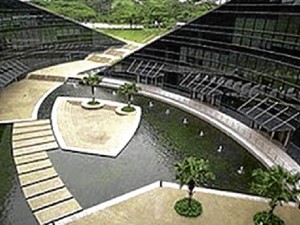
THE SCHOOL of Art, Design and Media in Singapore features a water collection system integrated on the green roof for irrigation. The rain sensors are installed on the green roof for automatic irrigation when it rains.
Our cavemen and hunter human ancestors showed almost no increase in number from just a few millions over hundreds of thousands, or even millions of years.
We became more than six billion at the beginning of this century, as daily energy consumption of man went up more than a hundred thousand times.
Daily energy consumption
Man living on hunted animals and gathered plants spent only 2,000 kilo-calories per day as animals do. Human energy consumption rose to 5,000 kilo-calories when man learned to cook meals with fire.
After acquiring agricultural technology, man graduated from the use of cows and horses, to windmills and watermills for irrigation, using 12,000 kilo-calories per day.
Then marine technology came. The Industrial Revolution in the 18th century saw man mining and using the earth for energy resources such as coal and petroleum. Man’s energy consumption jumped to 80,000 kilo-calories per day.
Today man consumes no less than 250,000 kilo-calories daily on a global average, of which 40 percent goes to production, 30 percent to residential educational commercial, 30 percent to transportation.
The increase in energy consumption by a hundred thousand times brings our energy consumption per year to almost one percent of the solar energy radiated to earth.
Urban heat island effect
As if global warming is not enough, when we have the skyway in the south of town working well, and better water services, the whole stretch of the service road is now strung with condominium projects promising urban heat island effect in the area, among others. Urban heat island effect is 2-3 degrees Celsius higher and is therefore worse than global warming.
There is a need for balanced allocation of urban land, resilient urban landscape through green spaces and risk sensitive land use planning. We all cannot afford end of the pipe thinking.
We hope transport-oriented development will receive full government support in the way of road and traffic design and management, transport strategy, better drainage system.
When Tropical storm “Ondoy” hit us three years ago, the whole length past SM Bicutan to Merville on the service road was waist-to-neck-deep in floodwater for several hours.
Government laws take charge when it comes to pollution control and nature preservation. But in matters of energy consumption, voluntary and economic measures prevail.
Technical standards
Energy-saving regulations for buildings can be placed in the hands of the building permit officials. Therefore the technical capabilities and systems of government inspectors are crucial.
Technical standards for design and assessment of buildings are in place at the government-accredited building professional organizations’ Philippine Green Building Initiative or PGBI.
Energy-saving performance can be checked during the life of the building. This will encourage building occupants to live the highly prescribed mantra of “consume less.”
To consume less will necessarily lead to reduced waste generation and less impact of waste disposal on the living and natural environment.
GHG emissions mostly from power plants can be reduced if we have less appetite for the world’s resources.
For comments or inquiries, e-mail amadodejesus@gmail.com.